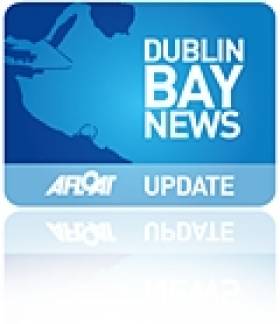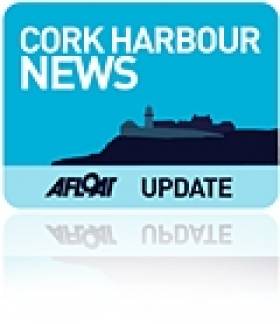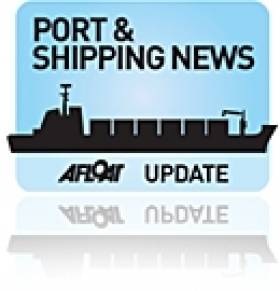Displaying items by tag: TS Empire State
#UStrainingShips –Afloat.ie can now confirm following our previous report, that the US training ship T.S. Empire State (1962/14,557grt) had made a 'sail-past' only visit of Dublin Bay this morning while en route to Copenhagen.
The vessel is no stranger to Dublin Port having called on previous occasions.
The brief appearance of the former general cargoship on US Independence Day, involved the vessel circling around the southern end of the bay before departing off the Baily Lighthouse.
On board are male and female students from the Maritime College of the State University College of New York (SUNY) who are undertaking their Summer Sea Term, which is held annually.
#UStrainingShips -Today been the 4th July, the United States celebrates its Independence Day where patriotic events take place also overseas and on board a pair of training vessels in Irish waters, writes Jehan Ashmore.
As previously reported on Afloat.ie, the two US training ships visited Cork recently, SSV Corwith Cromar and TS Empire State (1962/14,557grt) though the latter vessel this morning arrived into Dublin Bay.
As part of her annual Summer Sea Term, she is scheduled to visit several European ports and among them the next port is call is understood to the Danish capital of Copenhagen.
The arrival into Dublin Bay of the cadetship with students from the Maritime College of the State University College of New York (SUNY) is somewhat surprising, though for the last three days she undertook training exercises held off Cork Harbour with overnight anchorage taken offshore.
It remains to be confirmed if the former general cargoship which has visited Dublin Port previously is set to make an un-scheduled call.
Or this could merely be a 'sail-past' of Dublin as part of the route taken of the Empire State during her passage through the Irish Sea, past Scotland and onward to Scandinavia.
Also following a transatlantic sail from the US East coast, the other training vessel, the steel-hulled 1988 built SSV Corwith Cramer which made her first visit to Cork. She remains berthed at Cork City Marina where she was open to the public last Sunday.
On Tuesday a talk "One Ocean: Lightening Talks on Ocean Discovery" was held on board with researchers from the US and Ireland. She is due to depart on Sunday.
#TrainingShip – Veteran US merchant training ship T.S. Empire State (1962/14,557grt) arrived into Cork Harbour this morning, the Irish port forming one of several European ports of call as part of an annual Summer Sea Term, writes Jehan Ashmore.
The former general cargo vessel crossed the Atlantic Ocean, where around 500 male and female cadets from the Maritime College of the State University College of New York (SUNY) will get hands-on experience to learn seafaring skills to compliment their classroom based studies.
This year's Summer Sea Term involves calls to ports in U.S. East coast ports, Portugal, Canary Islands and Denmark. The voyage will provide an opportunity to visit Western Europe and exposure to cultures overseas.
The cadets at SUNY Maritime enroll for four-years at the college which offers undergraduate and graduate degrees.
Launched in 1961, the Empire State was laid down originally as the general cargos ship SS Oregon at Newport News Shipbuilding and Drydock Company in Virginia. Her career began with States Steamship Company for service in the Pacific trades.
In design terms, her era is reflected through her classic hull form lines, cargo derricks and large superstructure compared to her modern container counterparts.
For further details of the ships interim career prior to her current role in which she has served since 1990, click this Link.
Empire State is no stranger to Irish ports as last year's Sea Term included Dublin Port. Her arrival today to Cobh, where the majority of cruise ships berth will provide something different for onlookers to witness.
US Training Ship to Visit Dublin Port
#TrainingShip – The veteran US training ship T.S. Empire State (1962/14,557grt) arrived into Dublin Bay yesterday having crossed the Atlantic Ocean, she is however not due to dock in Dublin Port until tomorrow, writes Jehan Ashmore.
Operated by the SUNY Maritime College, University of New York, the 565-foot Empire State provides an essential component of the maritime experience for trainee cadets during the annual Summer Sea Term.
Cadets travel across the world learning about the hands-on operations of the ship which complements classroom studies while gaining exposure to international cultures.
This year's Summer Sea Term calls to ports in the U.S Gulf Coast, Canada, Ireland, Italy and Malta.
The cadets at SUNY Maritime enroll for four-years at the college which offers undergraduate and graduate degrees. As well as the summer training-ship cruises, there are 20 varsity athletic teams, five ROTC options, US Coast Guard license and intern programs.
Empire State was laid down originally as the general cargos ship SS Oregon at Newport News Shipbuilding and Drydock Company in Virginia and launched in 1961. Her career began with States Steamship Company for service in the Pacific trades.
Note the vessel's design of a different era as expressed through her classic hull form, fitting of cargo derricks and large superstructure compared to her modern container counterparts. For further details of the ships interim career prior to her current role in which she has served since 1990 click this Link.



























































